Roland Boutique Series Review Part Two
Andy Jones his review of the Roland’s conceptually brilliant Boutique series… The K-25m I will take a quick diversion now to talk about the the K-25m, as it was about here in my tests that I first used it with the JP module. You connect it up by simply slotting the module in after connecting […]

Andy Jones his review of the Roland’s conceptually brilliant Boutique series…
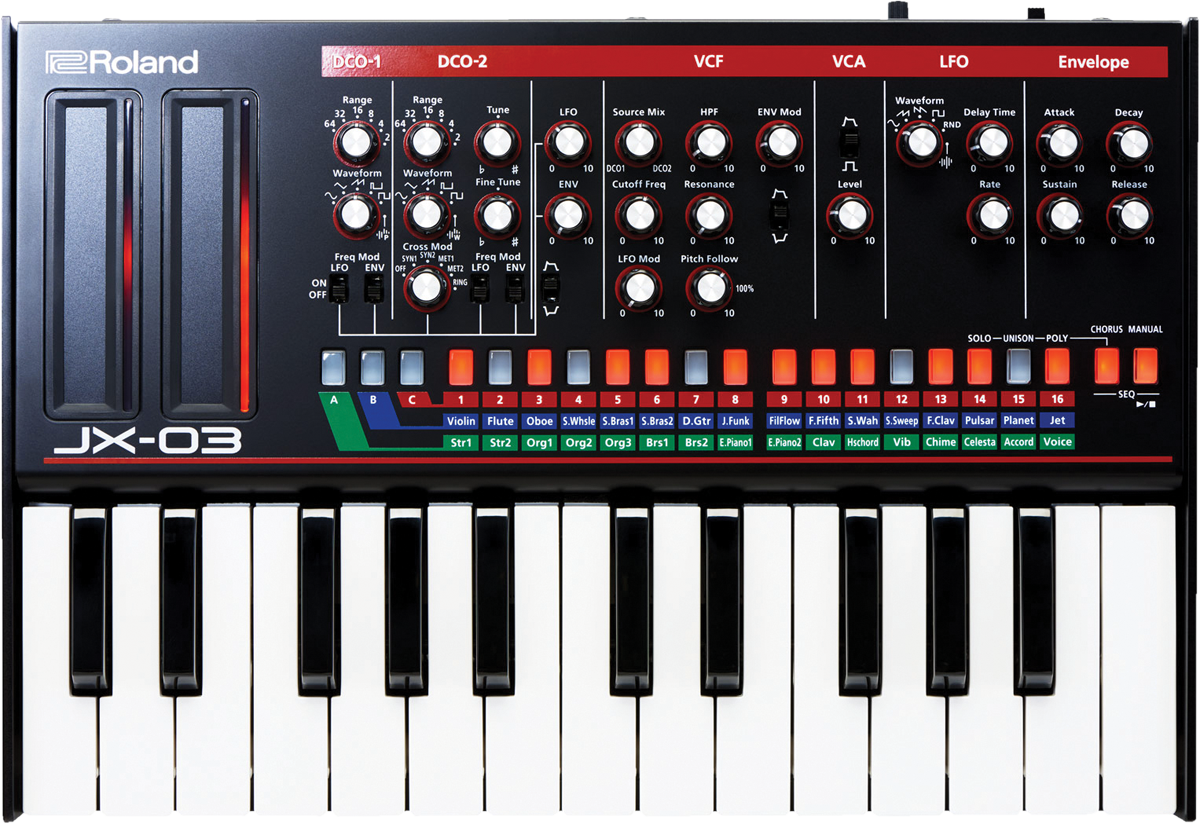
The K-25m
I will take a quick diversion now to talk about the the K-25m, as it was about here in my tests that I first used it with the JP module. You connect it up by simply slotting the module in after connecting up a ribbon-type pin connector. It’s as simple as anything, and certainly makes playing the synth fun and easy. Effectively, you now have a portable synth as the batteries and speaker really come into their own.
I do have some problems with it, though. The keyboard action is what Roland would describe as ‘aimed at the EDM generation’ – more trigger than player. And, while the concept works well – brilliantly in fact – the end result looks, well, how can I say this politely? A bit childish. It looks, quite literally, like a toy version of the real thing.
And this illusion of ‘toyness’ is enhanced further with the module in its upright position. I even had an image of a synthesiser birthday cake in my head for some reason. Of course, you might not think it looks like this at all but, personally, I’ll be keeping all three units on my desktop, chained together and looking dead cool, but with my own keyboard triggering them. But, but, but…
A Jupiter 8 (OK, 4), mobile, battery operated, and one that fits in a handbag? Admit it, you want one, don’t you?
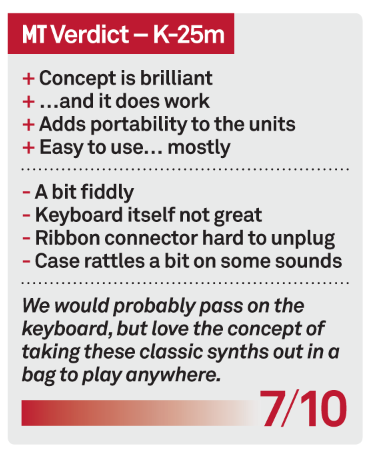
The JU-06
On to the JU-06, and the Juno-106 that it’s modeled on is one of the company’s all-time favourites. It was – and probably still is – used by Depeche Mode, Underworld and The Chemical Brothers (and, of course, Vince Clarke. – he has everything). It was a fully programmable poly synth – a stable analogue thanks to a DCO architecture. It sells for £650-£1,200, so a lot more than the new JU-06.
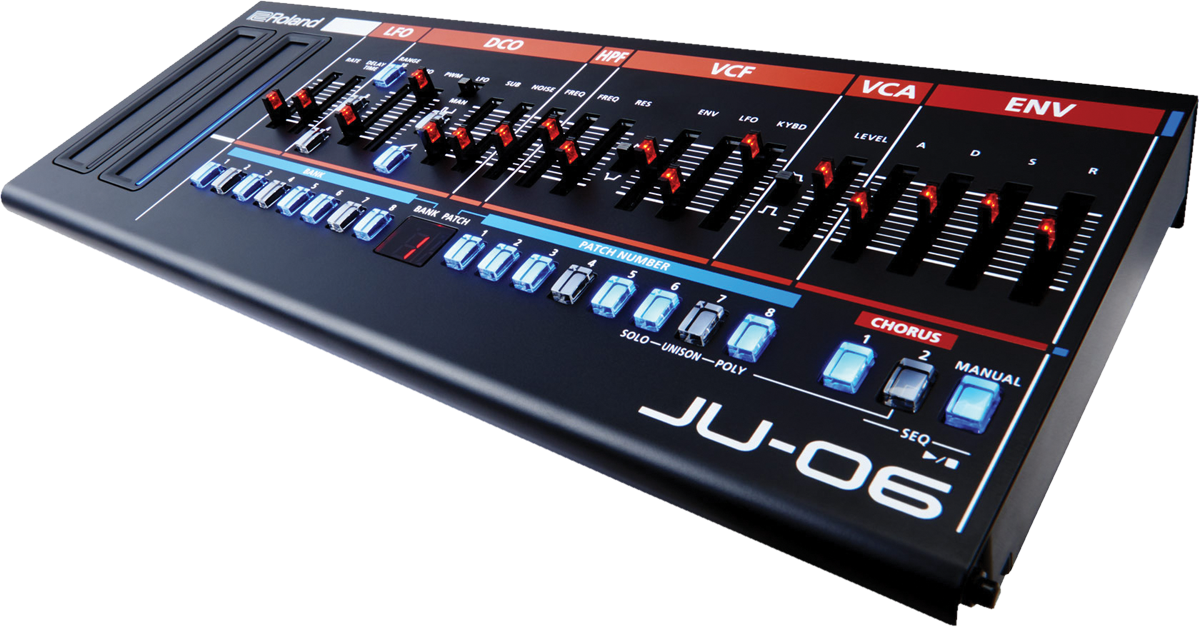
Again, you can stack JU-06s together to double the standard 4-voice polyphony…
Again, you can stack units to double polyphony (you get four to start with, compared to six on the original). There are 23 controls on the front panel, plus a faster LFO and a continuously variable hi-pass filter for a smoother sound. There’s a sequencer and it’s pretty much the same form as the JP-08 – easy to use with the Manual button and controllers.
I did notice a little noise when leaving the unit on its own, something that I didn’t get with the JP-08, and I later realised that this was with the optional chorus effect switched in. Also, with the module upright in the optional keyboard, the speaker did tend to rattle the casing a bit, so
I would suggest using it flat to reduce this, or lose the keyboard altogether.
Again, this is an issue that I didn’t experience with the JP.Sound-wise, the JU is a little more consistent than the JP, which has its Dual mode to add fat. You select sounds via bank and then patch number – a little different from the JP, but just as easy.
The sounds are beefy lows and searing leads and pads – just what the original is famed for – and it incorporates a few more noisy elements that add a bit of variety as you step through them. The additional chorus effects really do help to add some depth, too.
If I sound slightly underwhelmed I’m not, but there is a reason for my perceived lack of excitement. As I was going through the sounds I was feeling lots of familiarity – nothing that blew me away, just some very good workmanlike sounds, but then I realised why I had this almost deja vu feeling. The Juno is probably the synth I’ve used more than any other as an emulation on my computer: from the Creamware Pulsar’s U Know synth through to various freeware plug-ins.
The sheer number of people who have tried to recreate it is testament to its sound – it makes great synth basses, pads and leads, simple! It’s a proper solid synth and one with a simple architecture that you will easily get your head around, so it’s one for good old-fashioned and fast programming.
JU-06 Front Panel Overview
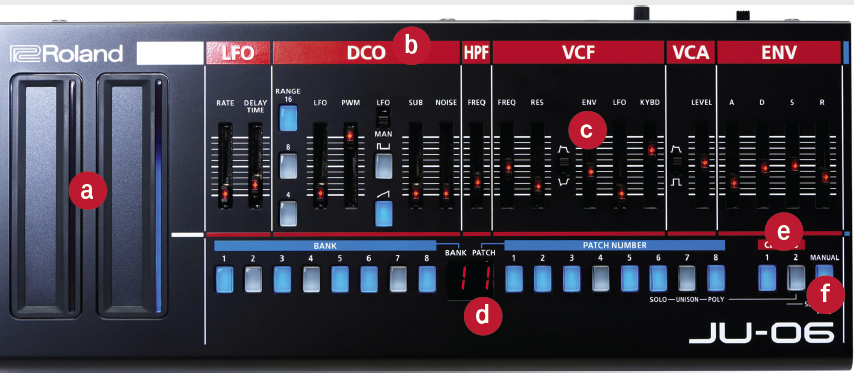
a: Controllers – Two lit controllers set to pitch and modulation, but can be used for a variety of data-setting tasks.
b: DCO – As with the original, a DCO offers stability (even though the full path is an emulation of analogue).
c: Architecture – Simple but effective, it’s a workhorse synth with ‘proper’ sounds that you can program easily.
d: Sound Selection – Unlike the JP, you select by bank and then patch number to load up each sound.
e: Chorus Effects – Help fatten the sound with two effects, but these can add a little noise to the output so beware.
f: Sequencer – As with the JP, you can program your 16-part step sequencer here.
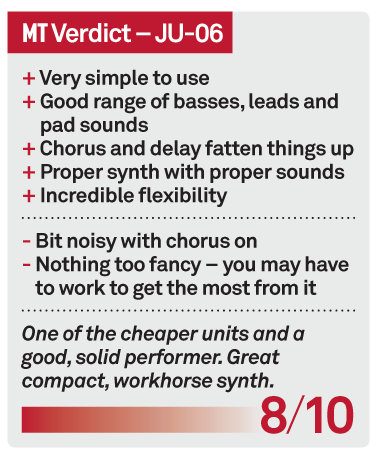
The JX-03
The JX-3P was another much-loved Roland synth, but not purely analogue. It had a digitally controlled oscillator but a subtractive analogue architecture – a bit of each, then – so possibly suited more than the other original synths to be reborn in Boutique. I remember the original well, as I had the chance to pick up one and its optional PG-200 programmer (which added 24 controllers to help open up the synth) for a song. You can too – not for silly money, maybe £400-600, but still more than this unit will cost you.
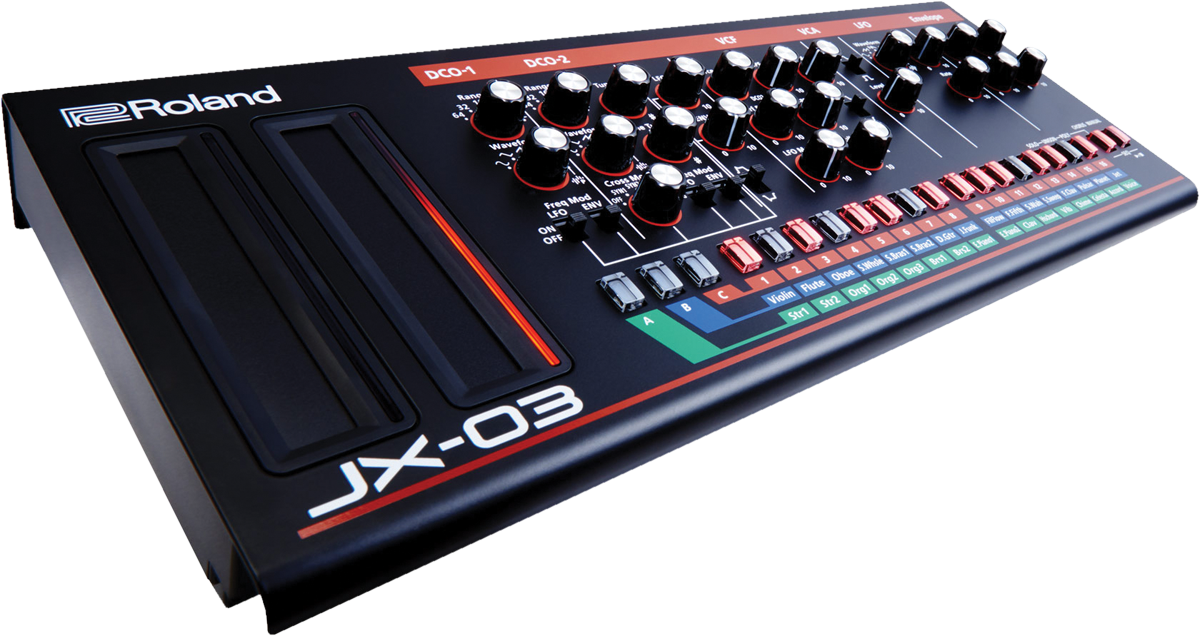
The JX-03 comes with the engine and programmer of the original synth all in the one unit…
But the real beauty of the JX-03 is that both the aforementioned units are merged into one box, so you get the original engine (albeit an emulation) and all of the controls of the original programmer. Again, there are additions: new waveforms, expanded DCO and modulations.
There are 32 presets and user locations – just like the original – plus that 16-part sequencer. Again, this utilises the controllers (should you not have the keyboard) to change parameters and works in exactly the same way as the JP sequencer, as detailed above.
In terms of sound, you can quickly understand why the original became a firm favourite for the likes of Orbital and Thomas Dolby, but the emphasis here, as with the original, – with the presets anyway – is on recreating real sounds. Uh-oh, this has always been one of my hates with synthesisers: when they have a world of sound to explore and use all of that energy in recreating brass. No thanks.
So what we get are two banks of 16 sounds, starting with good strings and organs (I won’t even mention the brass) and then moving through other keyboard instruments, then violins, guitar effects and some more synthy sounds.
In the main, it does a great job of recreating the original sounds, so if you liked them then you’ve come to the right place. If, that is. To be fair to the original, though, it was what the synth could do beyond these sounds that won it so many fans – and all of that is present and correct plus, of course, all of the controls from the original programmer to change these sounds.
What you are being encouraged to do – you could assume, especially given the 16 user locations – is move away from your base sounds and create your own, and this is where the JX-03 comes into its own. With two DCOs and a very simple architecture, you will soon be creating your own fat sounds, and the onboard chorus and delay help sounds move even further.
Of the three Boutique units, then, this is the one to tweak, but its lack of onboard controller lights – compared with the JP anyway – might be a little more offputting for doing this. I did feel that the sequencer was also more of an essential with the JX, as you’ll want to use it more creatively, whereas I can’t help thinking I’ll just use my DAW via USB to sequence the other two.
JX-03 Front Panel Overview
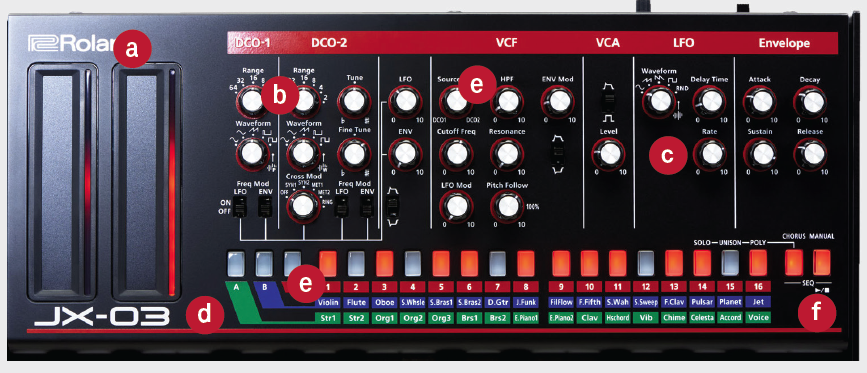
a: Ribbon Controllers – No keyboard attached? Use these to adjust values and more.
b: Dual Dcos – These offer a fatter sound, especially when combined with the effects.
c: Simple Architecture – Again, like the JU, this is so easy to use, and you wil want to fill those user spaces with your own sounds.
d: Bank A – The green bank offers everything from strings to accordian. And brass. Bloody brass.
e: Bank B – The blue bank has violins, guitars and more brass.
f: Sequencer – The 16-part sequencer is, as on the other two, easy to use and more beneficial to this module.
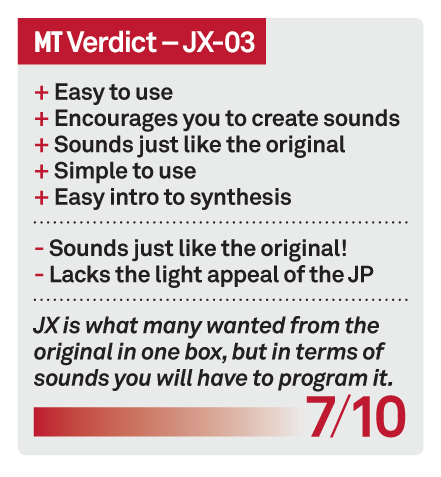
Conclusion
So it’s a mixed bag really. We get three classic synths with a lot in common – sequencer, some effects, neat controllers, touch strips, some lights, plus an optional keyboard – but three quite different synths for different people. But, hey, so were the originals.
Sound-wise, there are those saying that they match the originals. While I did try matching the AIRAs with their dance classics – with pretty positive results, I’d have to say – sadly, I didn’t have access to a £10k Jupiter for this (by all means send me one if you have one spare, though), so I can’t tell you exactly.
What I can say is that the true analogues that I do have in my studio exhibit a warmth and depth that is notable, as you’d expect. But use these units with the same speakers (ie, not their onboard ones) and you’d be hard pressed to tell which are which on certain sounds.
I’m not really convinced Roland is touting these as direct analogue replacements to the originals anyway. I’d say they are fun and portable versions, not authentic replications of the sound – and in that respect, and for the money they are being sold for, they are great (I wonder, too, as Roland has the System 500 analogue ready and waiting, whether we will see true analogue reissues of these. Oh yes!).
One thing that you will agree with me on – with all three of these synths – is that they are clearly one hell of a lot of fun. Stack them, line them up, light them up, take them anywhere, and they do a super-fun job. They are also among the most tweakable little modules I’ve come across, with a surprisingly sturdy feel and lovely action on the controls – you will make new sounds with them, and that’s what synths are all about. I’m more excited about what the K-25m offers than how it delivers it.
I love the idea of bringing out the JP-08 at a party to impress and simply playing a classic synth right there (and yes that says more about how sad I am and the kind of parties I get invited to than anything else, but you know what I mean).
Sadly, the K-25m doesn’t quite fulfil the promise, and the shell itself is a little fiddly, but I do want to congratulate whoever came up with the concept because I love it. I’d have been happy to pay a few more quid for a bit more quality, but maybe that’s just me.
Sadly all of my missives could well be a load of words that are thrown down an abyss and never retrieved because Roland might well be making these limited, which is a shame.
The concept is brilliant, as is the price. I also love the size (which surprises me) and would love to see more. I’ve just bought a proper and very big analogue synth, which sounds better for sure, but over two months of owning these I found myself using them more – I even got used to that keyboard (OK, a bit).
Sure, they might not match that classic analogue for its sound and range, but for pick up and play ‘classic’ synths they can’t be beaten, and there’s nothing else out there quite like them. If they really are gone, that really is a bummer.
Key Features
● JP-08, JU-06, JX-03, K-25m
● JP-08 Polyphony: 4; 64 patches; 8 patch presets; 36 controllers; delay effect
● JX-03 Polyphony: 4; 32 patches, 16 user; 23 controllers; chorus & delay effects
● JU-06 Polyphony: 4; 64 patches; 24 controllers; chorus & delay effects
Shared
● 16-part step sequencer
● Rechargeable battery, 6-hour charge
● Connections: USB bus power/MIDI, mini input and output jacks, MIDI I/O, volume rotary
● Weight: 940g to 970g
● Size: 300x128x45mm